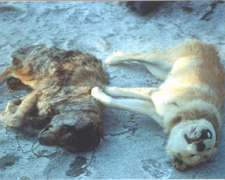Earthroots and the Wolves
Ontario! Project are calling for an end to the unrestricted snaring
of wolves.
The snare is
a simple noose made of aircraft-grade steel cable. It is designed
to tighten as the animal pulls against it; a metal catch prevents
it from loosening. The animal dies through strangulation. Snares
frequently have to be replaced after a capture; bent out of shape
by the animals that struggled to escape.
Since snares
are quick and cheap to make, trappers often set many in one given
area. A set of snares located around a piece of bait or a chemical
lure along well-traveled wildlife paths can effectively trap an
entire wolf pack. The technique is known as "saturation snaring".
 Wolves can be trapped and snared between September 15th- March
31st throughout most of their range. There are no limits
to how many wolves can be killed in this way.
Wolves can be trapped and snared between September 15th- March
31st throughout most of their range. There are no limits
to how many wolves can be killed in this way.
 Snares are not selective trapping devices. For every wolf caught
in a snare, it is expected that at least one other animal had
been caught accidentally. 35 moose, 14 caribou, 26 red foxes,
10 coyotes, 4 golden eagles, 2 grizzly bears and 3 wolverines
were unintentionally caught in snares set for Alaskan wolves during
a two-year wolf control program.
Snares are not selective trapping devices. For every wolf caught
in a snare, it is expected that at least one other animal had
been caught accidentally. 35 moose, 14 caribou, 26 red foxes,
10 coyotes, 4 golden eagles, 2 grizzly bears and 3 wolverines
were unintentionally caught in snares set for Alaskan wolves during
a two-year wolf control program.
 Snares kill endangered species. Snares are durable, difficult
to find, remain in place for years and will potentially harm any
animal that comes across it first, including endangered species
and dogs. Accidental snaring was a major factor contributing to
the endangerment of the Newfoundland Pine Martin.
Snares kill endangered species. Snares are durable, difficult
to find, remain in place for years and will potentially harm any
animal that comes across it first, including endangered species
and dogs. Accidental snaring was a major factor contributing to
the endangerment of the Newfoundland Pine Martin.
Though there
are snare bans in place in 17 American states and the United
Kingdom, snares are the number one killer of wolves in Ontario!

 Since most snares are homemade, there are no manufacturing standards
to meet.
Since most snares are homemade, there are no manufacturing standards
to meet.
 The vast majority of Ontarians are against the use of snares.
In a recent survey conducted by OraclePoll Research, 83% of the
respondents were concerned that snares are legal.
The vast majority of Ontarians are against the use of snares.
In a recent survey conducted by OraclePoll Research, 83% of the
respondents were concerned that snares are legal.
 Snares are not selective in what they target. Dogs, cats and endangered
species can be unintentional victims of snaring. For every wolf
caught in a snare, it is expected that at least one other animal
had been caught accidentally.
Snares are not selective in what they target. Dogs, cats and endangered
species can be unintentional victims of snaring. For every wolf
caught in a snare, it is expected that at least one other animal
had been caught accidentally.
 Of the 707 Ontario wolves killed in 1995 for the commercial sale
of their pelts, 93% were caught in neck snares.
Of the 707 Ontario wolves killed in 1995 for the commercial sale
of their pelts, 93% were caught in neck snares.
Why are
wolves snared?
A gray wolf with its head and claws still intact can fetch
$350 US and is most often used for a rug. The pelt is also used
for trim on winter coats. Some wolves are killed in order to
maintain prey populations (deer, moose and beaver). Others are
killed just because they are hated, feared or misunderstood.
Get involved
with Earthroots' Wolves Ontario! Project and stop the indiscriminate
snaring of wolves in Ontario!